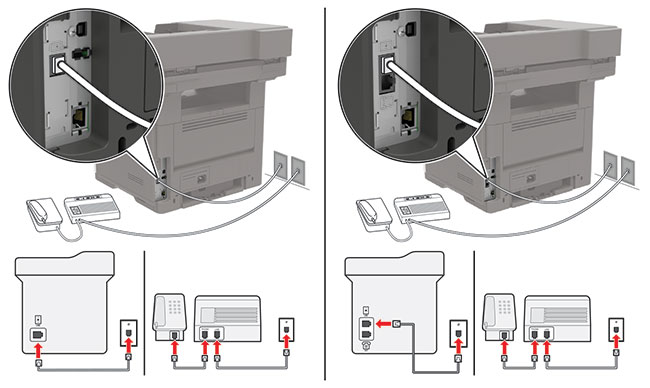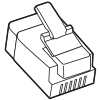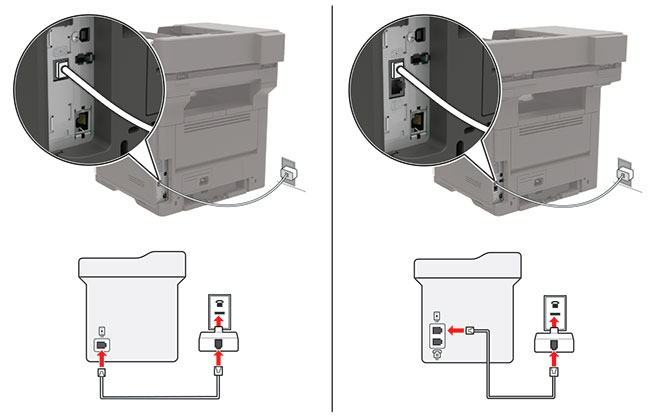
Notes:

Printer model | Analog fax | etherFAX1 | Fax server | Fax over IP (FoIP)2 |
|---|---|---|---|---|
1 Needs a subscription. For more information, go to https://www.etherfax.net/lexmark or contact the place where you purchased the printer. 2 Needs an installed license bundle. For more information, contact the place where you purchased the printer. | ||||
MB2442adwe |
|
|
|
|
MB2546ade |
|
|
|
|
MB2546adwe |
|
|
|
|
MX421ade |
|
|
|
|
MX521de | X |
|
|
|
MX521ade |
|
|
|
|
MX522adhe |
|
|
|
|
MX522dhe | X |
|
|
|
XM1242 |
|
|
|
|
XM1246 |
|
|
|
|
XM1246i | X |
|
|
|
Notes:

From the home screen, touch Settings > Fax > Fax Setup > General Fax settings.
Configure the settings.
Open a web browser, and then type the printer IP address in the address field.
Notes:
Click Settings > Fax > Fax Setup > General Fax Settings.
Configure the settings.
Apply the changes.
Notes:
Open a web browser, and then type the printer IP address in the address field.
Notes:
Click Settings > Fax > Fax Setup > General Fax Settings.
In the Fax Name field, type a unique name.
In the Fax Number field, enter the fax number that etherFAX provided.
From the Fax Transport menu, select etherFAX.
Notes:
Apply the changes.
Notes:
Open a web browser, and then type the printer IP address in the address field.
Notes:
Click Settings > Fax.
From the Fax Mode menu, select Fax Server, and then click Save.
Click Fax Server Setup.
In the To Format field, type , where is the fax number and is the fax provider domain.
Notes:
Click Save.
Click Fax Server E-mail Settings, and then do either of the following:
Enable Use E-mail SMTP Server.
Configure the SMTP settings. For more information, contact your e-mail service provider.
Apply the changes.
 CAUTION—SHOCK HAZARD: To avoid the risk of electrical shock, do not set up this product or make any electrical or cabling connections, such as the power cord, fax feature, or telephone, during a lightning storm.
CAUTION—SHOCK HAZARD: To avoid the risk of electrical shock, do not set up this product or make any electrical or cabling connections, such as the power cord, fax feature, or telephone, during a lightning storm. CAUTION—SHOCK HAZARD: To avoid the risk of electrical shock, do not use the fax feature during a lightning storm.
CAUTION—SHOCK HAZARD: To avoid the risk of electrical shock, do not use the fax feature during a lightning storm. CAUTION—POTENTIAL INJURY: To reduce the risk of fire, use only a 26 AWG or larger telecommunications (RJ-11) cord when connecting this product to the public switched telephone network. For users in Australia, the cord must be approved by the Australian Communications and Media Authority.
CAUTION—POTENTIAL INJURY: To reduce the risk of fire, use only a 26 AWG or larger telecommunications (RJ-11) cord when connecting this product to the public switched telephone network. For users in Australia, the cord must be approved by the Australian Communications and Media Authority.
Connect one end of the telephone cable to the line port of the printer.
Connect the other end of the cable to an active analog telephone wall jack.
Notes:
Connected to the same telephone wall jack

Connect one end of the telephone cable to the line port of the printer.
Connect the other end of the cable to an active analog wall jack.
Connect the answering machine to the telephone port of the printer.
Connected to different wall jacks

Connect one end of the telephone cable to the line port of the printer.
Connect the other end of the cable to an active analog wall jack.
Notes:
 CAUTION—SHOCK HAZARD: To avoid the risk of electrical shock, do not set up this product or make any electrical or cabling connections, such as the power cord, fax feature, or telephone, during a lightning storm.
CAUTION—SHOCK HAZARD: To avoid the risk of electrical shock, do not set up this product or make any electrical or cabling connections, such as the power cord, fax feature, or telephone, during a lightning storm. CAUTION—SHOCK HAZARD: To avoid the risk of electrical shock, do not use the fax feature during a lightning storm.
CAUTION—SHOCK HAZARD: To avoid the risk of electrical shock, do not use the fax feature during a lightning storm. CAUTION—POTENTIAL INJURY: To reduce the risk of fire, use only a 26 AWG or larger telecommunications (RJ-11) cord when connecting this product to the public switched telephone network. For users in Australia, the cord must be approved by the Australian Communications and Media Authority.
CAUTION—POTENTIAL INJURY: To reduce the risk of fire, use only a 26 AWG or larger telecommunications (RJ-11) cord when connecting this product to the public switched telephone network. For users in Australia, the cord must be approved by the Australian Communications and Media Authority.The standard wall jack adopted by most countries or regions is RJ-11. If the wall jack or equipment in your facility is not compatible with this type of connection, then use a telephone adapter. An adapter for your country or region may not come with your printer, and you may need to purchase it separately.
There may be an adapter plug installed in the telephone port of the printer. Do not remove the adapter plug from the telephone port of the printer if you are connecting to a serial or cascaded telephone system.

Part name | Part number |
|---|---|
Lexmark adapter plug | 40X8519 |

Connect one end of the telephone cable to the line port of the printer.
Connect the other end of the cable to the RJ-11 adapter, and then connect the adapter to the wall jack.
If you want to connect another device with a non-RJ-11 connector to the same wall jack, then connect it directly to the telephone adapter.
A distinctive ring service lets you have multiple telephone numbers on one telephone line. Each telephone number is assigned a different ring pattern.
From the home screen, touch Settings > Fax > Fax Setup > Fax Receive Settings > Admin Controls > Answer On.
Select a ring pattern.
From the home screen, touch Settings > Device > Preferences > Date and Time > Configure.
Configure the settings.
From the home screen, touch Settings > Device > Preferences > Date and Time > Configure.
In the Time Zone menu, select (UTC+user) Custom.
Configure the settings.